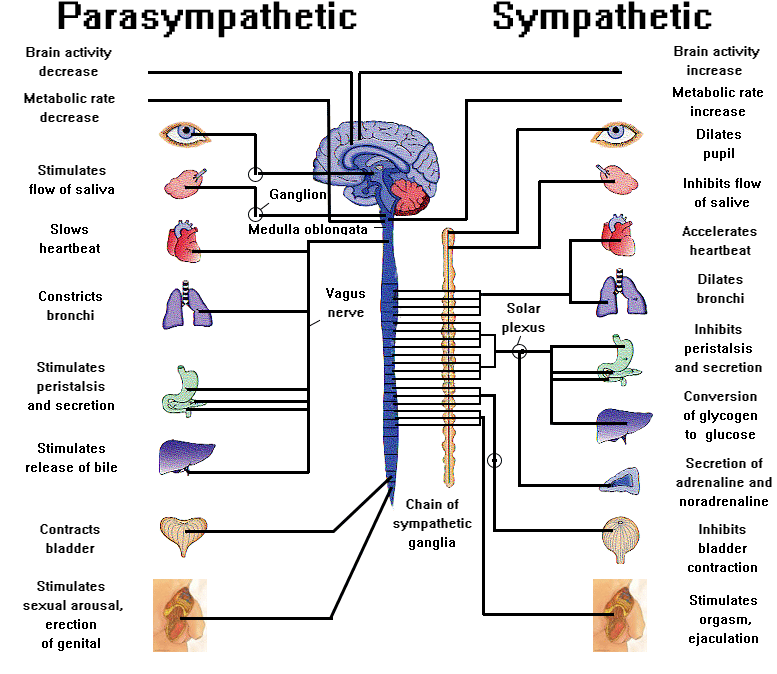The Autonomic nervous system (ANS) includes the sympathetic and parasympathetic systems, which are responsible for communicating with our organs and endocrines, including digestive (the Enteric Nervous System), heart rate, other speeding and slowing body processes, function of involuntary smooth muscles, etc.
Here is a brief breakdown of it’s parts and how we can sense when our body is experiencing different aspects of FFF or the more relaxed aspect of the parasympathetic system.
1) Ventral Vagal (VV) branch of the Parasympathetic Nervous system, which is active when we are most relaxed, and influences our heart, lungs, facial expression, intonation and vocalization, even the middle ear. It acts as the first line of defense for humans, through social engagement and befriending the other; it will tell us if we are safe or not safe. Our facial expression conveys our state, e.g. when we feel safe, our face is open and relaxed with healthy colour tone, voice is melodic using a range of tones and speech is paced (not fast or breathless).
2) Sympathetic Nervous System engages when the social engagement system does not work, which can enable huge levels of mobilization, fight/flight. We will then try to fight with arms, or flee with legs to find safety.
Fight – hold breath or rapid shallow breathing, tension in muscles, hands, feet and jaw, anger/rage, impulse to bite, kick, claw, narrow eyes, cortisol, etc.
Flight – urgency, fear, anxiety, restlessness, hold breath or rapid, shallow breathing, arousal in limbs – tremble shaking, urge to flee, cortisol, etc.
3) Dorsal Vagal (DV) branch of the parasympathetic nervous systems conserves energy and stimulates automatic at rest activities. In defense mode, this system shuts down and freezes (tonic immobility), if FF was unsuccessful because FF eventually exhausts us. It results in paralysis, hiding, disappearing, numbing, low oxygen, dissociation, shock, panic, overwhelm. Face becomes pallid, breath is shallow, pupils become small, and muscles flaccid lacking tone.
Vagal communication is coming 80% from the gut (Enteric Nervous System), to the brain so when the gut shuts down, the brain knows something is wrong. The heart, lungs and all organs slow down and the person often dissociates. (Note that the DV has rest and digest at one end of it, and freeze at the other.)
All of our organism’s health focus relates to survival. If our body is stuck in FFF, the immune, digestive, cardio systems, etc. can’t repair themselves, e.g. Neurodegenerative health issues often correlate with early developmental stressors. (Much research on this by Dr. Gabor Mate.)
When we carry these high levels of stress inside for long periods of time, our health eventually breaks down. (The higher our Adverse Childhood Experiences Score ~ ACE score, the higher chances that this may happen).
Notice what’s happening in your body as you read this. If there is constriction (hyperarousal ) or emptiness/numbness (dissociating/freezing) surfacing in the muscles, see if you can start to feel into some open, warm, fluid resources that are also within your body and/or something that is easy to look at in your environment. If you notice that you are freezing, you can also move your eyes and body using subtle or medium movements to bring yourself back into a relaxed VV Parasympathetic State.
Welcome to your Autonomic Nervous System!




